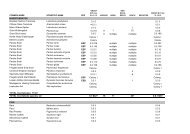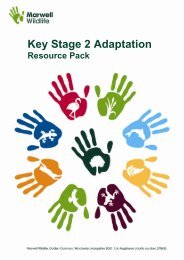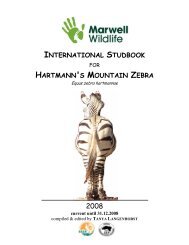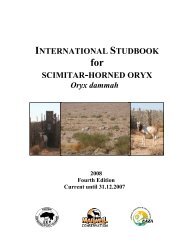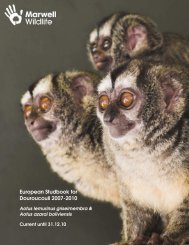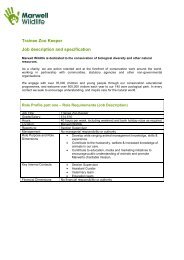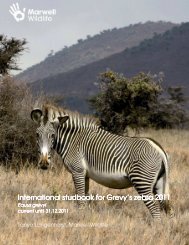Hartmann's mountain zebra studbook 2011 - Marwell Zoo
Hartmann's mountain zebra studbook 2011 - Marwell Zoo
Hartmann's mountain zebra studbook 2011 - Marwell Zoo
Create successful ePaper yourself
Turn your PDF publications into a flip-book with our unique Google optimized e-Paper software.
Conservation Conservation Conservation research research on on <strong>mountain</strong> <strong>mountain</strong> <strong>mountain</strong> <strong>zebra</strong> <strong>zebra</strong> <strong>zebra</strong> in in in NNamibia<br />
NN<br />
amibia amibia<br />
Prof. L.M. Gosling, NIReS, University of Newcastle, Newcastle upon Tyne, NE1 7RU, UK; and<br />
Mountain Zebra Project, Namibia Nature Foundation, PO Box 245, Windhoek, Namibia.<br />
morris.gosling@newcastle.ac.uk<br />
I continued with individual-based monitoring at three main sites in southern Namibia during <strong>2011</strong> and<br />
started a pilot study in the Naukluft National Park. As before, the main practical techniques are camera<br />
trapping at water holes plus occasional field observations of wild groups. Here, I will focus on<br />
Gondwana Cañon Park (GCP) and NamibRand Nature Reserve (NRNR) where mark-recapture<br />
population estimates were carried out in the dry season of <strong>2011</strong> using camera trap data. These<br />
supplement estimates of numbers obtained from accumulating the numbers of individually recognised<br />
animals, a process that goes on continuously as camera trap images are analysed. This exercise has<br />
become more useful as the owners of GCP and NRNR have also acquired camera traps to create<br />
extensive monitoring networks. The <strong>mountain</strong> <strong>zebra</strong> populations in these two protected areas are<br />
healthy and are probably increasing and, from all reports, this seems to be the case in most other<br />
parts of Namibia. However, a new conservation threat is emerging, the potential problem of<br />
hybridisation with plains <strong>zebra</strong>, and this is discussed at the end of this report.<br />
AII<br />
Figure 1:<br />
Namibia showing the main blocks<br />
of contiguous protected areas (1,<br />
2 and 3) and <strong>mountain</strong> <strong>zebra</strong><br />
study sites. The map is modified,<br />
with permission, from one in a<br />
forthcoming review of the 'State of<br />
Biodiversity in Namibia' by Chris<br />
Brown.





